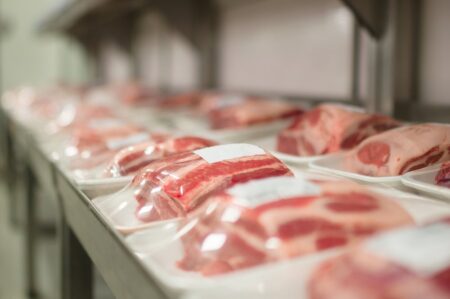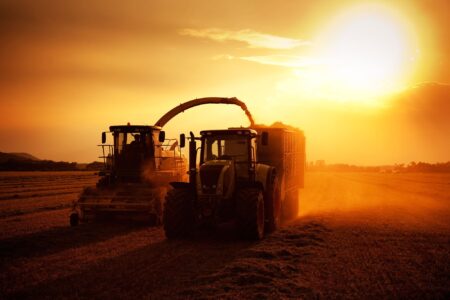On average, U.S. soybeans are progressing right on schedule. For the top 18 soybean-growing states, 89% of the crop reached the setting pods stage by Aug. 24, while 4% had reached the dropping leaves stage, USDA reported Monday. For both stages, that’s level with respective five-year averages.
But as soybeans progress, diseases are as well. Sudden death syndrome (SDS) is one of them.
SDS is caused by a fungus and is “one of the most recognizable diseases in the North Central soybean-producing areas of the United States,” according to the Crop Protection Network (CPN).
“Cool, wet field conditions shortly after planting favor early root infections and disease establishment,” according to a disease overview from CPN. The network said that frequent or heavy precipitation in the middle of the season can promote early SDS symptom expression in soybean fields.
Here’s a look at some of the places SDS is showing up across top soybean-growing states.
Iowa
Wyffels agronomist Eric Wilson, who supports southern and northeast Iowa, described the soybeans in his region mostly positively. “Aside from the wet holes, soybeans continue to hold very good color and look good,” he said.
But SDS was the one disease he described when asked about soybean disease pressure in his territory during the week ending Aug. 24, sharing that “a little more SDS has started to show in a few areas.” It was a stressor he reported the week prior as well.
Wilson said that while temperatures in his territory have cooled off, humidity has stuck around.
As of Aug. 24, 90% of Iowa’s soybeans had reached the setting pods stage, 3 percentage points behind the five-year average. None of the crop had reached the dropping leaves stage, USDA said, which is level with average.
USDA rated Iowa’s soybeans 20% excellent, 59% good, 17% fair, 3% poor, and 1% very poor.
Illinois
Western Illinois soybeans are “relatively disease-free in most areas,” according to Wyffels agronomist Ryan Gentle. He covers most of the west half of Illinois.
Yet SDS still got a mention in Gentle’s reporting. He said the disease can be found in a few early planted fields.
Gentle described “brutally hot” conditions in his area during the first part of the week ending Aug. 24, and then a cool down toward the weekend. “Most of the area got between 0.25 and 1 inch of rain, with heavier amounts from Canton to the north,” he said.
As of Aug. 24, 91% of Illinois’ soybeans had reached the setting pods stage, 3 points ahead of the five-year average. Two percent of the crop had reached the dropping leaves stage, ahead of the 1% five-year average.
USDA rated Illinois’ soybeans 16% excellent, 42% good, 26% fair, 11% poor, and 5% very poor.
Minnesota
In Minnesota, SDS is “showing up in fields across the state,” according to Syngenta agronomist Tim Dahl.
The weather in Minnesota the week ending Aug. 24 was extreme. Dahl described torrential rains across much of the state near week’s end.
As of Aug. 24, 93% of Minnesota’s soybeans had reached the setting pods stage, 1 point behind the five-year average. None of the crop had reached the dropping leaves stage, although the five-year average is 1%.
USDA rated Minnesota’s soybeans 20% excellent, 54% good, 20% fair, 5% poor, and 1% very poor.
Northwest Iowa, Southern Minnesota, and Eastern South Dakota
Jared Goplen, whose territory stretches between northwest Iowa, southern Minnesota, and eastern South Dakota, said diseases are changing soybean conditions in his area for the worse.
“Soybeans in general have looked pretty good until disease has started to walk some fields backwards. There have been a lot of spots showing up throughout my geography,” Goplen said.
“I suspect SDS to be the culprit in many of these spots to date, but know that the pockets of white mold are starting to get to the point where they become much more visible as well,” he shared.
Goplen said soil moisture in his territory is plentiful enough to finish out soybean grain fill but added a caveat: “It is a race between grain fill and disease pressure.”
As of Aug. 24, 85% of South Dakota’s soybeans had reached the setting pods stage, 5 points behind the five-year average. Just 2% of the crop had reached the dropping leaves stage, behind the 8% five-year average.
USDA rated South Dakota’s soybeans 25% excellent, 51% good, 18% fair, 4% poor, and 2% very poor.
Wisconsin
“Soybean development is nearly complete in southern Wisconsin,” said Nick Groth, a Syngenta agronomist in the Badger State. Progress is a bit behind further north in the state, he said.
Groth shared that at this point, diseases are really becoming noticeable.
“Sudden death syndrome, white mold, and Phytophthora all seem to be issues in fields across Wisconsin. I still think overall we have a good soybean crop, but it looks like late season disease will play a role in soybeans as well as corn,” he said.
As of Aug. 24, 86% of Wisconsin’s soybeans had reached the setting pods stage, 3 points behind the five-year average. None of the crop had reached the dropping leaves stage, which is on track with average.
USDA rated Wisconsin’s soybeans 25% excellent, 58% good, 13% fair, 3% poor, and 1% very poor.



:max_bytes(150000):strip_icc()/100441307_dairy_cow-2b8693c4806c45a1aa0e89b45bf0ab00.jpg)
:max_bytes(150000):strip_icc()/WhiteHouse-2000-251df9c5b90d4c7da5a9226a5c8f9dac.jpg)


:max_bytes(150000):strip_icc()/DSC_0046-2000-e4741e0202a74af18d1c72a963aebbff.jpg)


:max_bytes(150000):strip_icc()/Markets-5-Soybeans-dramatic-down-15-1dd1e8e5bab14a3b8e66f834c3b43908.jpeg)
